Small Business Introduction Letter
[Your Name]
[Your Title]
[Your Company Name]
[Your Address]
[City, State, ZIP Code]
[Email Address]
[Phone Number]
[Date]
[Recipient's Name]
[Recipient's Title]
[Recipient's Company Name]
[Recipient's Address]
[City, State, ZIP Code]
Dear [Recipient's Name],
I hope this letter finds you well. I am writing to introduce you to [Your Company Name], a dynamic and innovative small business that is dedicated to [briefly describe your business's mission or purpose, e.g., providing top-quality marketing solutions for local businesses, creating handcrafted artisanal products, offering personalized financial consulting services, etc.].
At [Your Company Name], we pride ourselves on [mention some unique selling points or values of your business, e.g., our commitment to delivering measurable results, our attention to detail in crafting each product, our extensive industry experience, etc.]. With a passion for excellence and a strong focus on customer satisfaction, we are confident in our ability to exceed your expectations.
Our range of services/products includes [mention a few key services or products your business offers, e.g., comprehensive digital marketing campaigns, a diverse selection of handcrafted jewelry, tailored financial planning packages, etc.], designed to cater to the specific needs and preferences of our clients.
What sets us apart is our [mention any distinctive features, e.g., cutting-edge technology, artistic craftsmanship, personalized approach, etc.]. We understand the challenges faced by small businesses like yours and are committed to helping you [state how your business aims to solve a problem or provide value to the recipient's company, e.g., enhance your brand visibility, streamline your operations, boost your financial growth, etc.].
I would welcome the opportunity to further discuss how [Your Company Name] can contribute to the success of [Recipient's Company Name]. Please feel free to reach out to me at [Email Address] or [Phone Number] to schedule a convenient time for a conversation. You can also visit our website at [Your Website URL] to learn more about our offerings and expertise.
Thank you for considering [Your Company Name] as a potential partner. We look forward to the possibility of working together and contributing to the growth and prosperity of both our businesses.
Sincerely,
[Your Signature]
[Your Printed Name]
[Your Title]
[Your Company Name]
[Your Phone Number]
[Your Email Address]
Professional Small Business Introduction Letter
Subject: Introduction of [Your Company Name]
Dear [Recipient Name],
I am writing to introduce [Your Company Name], a small business specializing in [Products/Services]. Our mission is to provide high-quality [Products/Services] tailored to meet the unique needs of our clients.
We would be delighted to explore opportunities for collaboration or to provide our services to your esteemed organization. Please feel free to contact us for further information or a meeting.
Thank you for your time and consideration.
Sincerely,
[Your Name]
[Position]
[Company Name]
Casual Small Business Introduction Email
Subject: Hello from [Your Company Name]
Hi [Recipient Name],
I hope this message finds you well! I wanted to introduce [Your Company Name], where we focus on [Products/Services]. We love helping clients with [specific solutions or benefits].
Looking forward to connecting and seeing if there’s a way we can work together.
Best,
[Your Name]
[Company Name]
Creative Small Business Introduction Letter
Subject: Meet [Your Company Name] – Your Partner in [Industry]
Dear [Recipient Name],
Imagine a business that truly understands your needs in [Industry]. That’s [Your Company Name]. We combine [unique selling points] with personalized service to deliver exceptional results.
We would love the opportunity to collaborate with you and demonstrate the value we can bring. Let’s schedule a time to discuss how we can support your goals.
Warm regards,
[Your Name]
[Company Name]
Heartfelt Small Business Introduction Letter
Subject: Introducing [Your Company Name]
Dear [Recipient Name],
It gives me great pleasure to introduce [Your Company Name], a small business dedicated to [mission or purpose]. Every project we undertake is infused with passion and commitment to our clients’ success.
We sincerely hope to build a lasting relationship with your organization and explore how we can assist you in achieving your objectives.
Kind regards,
[Your Name]
[Position]
[Company Name]
Quick Small Business Introduction Message
Subject: [Your Company Name] Introduction
Hi [Recipient Name],
I’m reaching out to introduce [Your Company Name]. We provide [Products/Services] designed to help businesses like yours [specific benefit].
Looking forward to connecting!
Best,
[Your Name]
Provisional Small Business Introduction Letter
Subject: Introduction of [Your Company Name]
Dear [Recipient Name],
I am reaching out to briefly introduce [Your Company Name]. We are currently exploring opportunities in [Industry/Area] and would love to discuss how our [Products/Services] may benefit your organization.
Please consider this a preliminary introduction, and we hope to arrange a more detailed discussion soon.
Sincerely,
[Your Name]
[Company Name]
What a Small Business Introduction Letter Is and Why It Matters
A small business introduction letter is a professional communication sent to potential clients, partners, or stakeholders to present your company, its offerings, and its value proposition. Purpose includes:
- Informing recipients about your business and services.
- Establishing credibility and professional presence.
- Creating opportunities for networking, partnerships, or sales.
- Opening channels of communication for future collaboration. It serves as the first impression of your business and can set the tone for ongoing relationships.
Who Should Send a Small Business Introduction Letter
- Business owners or founders.
- Marketing or business development managers.
- Authorized representatives for corporate outreach.
- Sales personnel initiating client engagement. The sender should be someone with authority to represent the business accurately and professionally.
Whom the Letter Should Be Addressed To
- Potential clients or customers who may benefit from your products/services.
- Prospective business partners or collaborators.
- Industry stakeholders, suppliers, or distributors.
- Networking contacts or referral sources. Choosing the correct recipient ensures the introduction is relevant and effective.
When to Send a Small Business Introduction Letter
- Upon launching a new business or product.
- When expanding into new markets or regions.
- Before attending networking events or trade shows.
- When seeking partnerships, clients, or referrals.
- During business outreach campaigns or marketing initiatives. Timely sending enhances the impact and relevance of the letter.
How to Write and Send a Small Business Introduction Letter
- Start with a clear subject line reflecting the purpose.
- Address the recipient appropriately and personally.
- Introduce your business, including name, mission, and offerings.
- Highlight key benefits, unique selling points, or differentiators.
- Invite the recipient to connect, schedule a meeting, or discuss further.
- Close politely with contact information and signature.
- Send via email, postal mail, or professional networking platforms depending on context.
Requirements and Prerequisites Before Writing
- Have a clear understanding of your business offerings and value proposition.
- Identify target audience or recipient list.
- Prepare marketing materials or supporting documents if necessary.
- Ensure correct contact details and proper recipient titles.
- Be clear about goals: networking, client acquisition, partnerships, or collaboration.
Formatting a Small Business Introduction Letter
- Length: 150–300 words for formal letters; 100–200 words for emails.
- Tone: Professional, friendly, and approachable.
- Style: Formal for corporate contacts; casual or creative for startups or informal outreach.
- Structure: Subject, greeting, introduction, business overview, value proposition, call to action, closing, signature.
- Mode: Printed letter, PDF, or digital email/message.
- Etiquette: Polite, concise, and focused on benefits for the recipient.
After Sending / Follow-up
- Confirm receipt of the letter if appropriate.
- Follow up with a call, email, or meeting request after a few days.
- Maintain notes on responses and interest levels for future engagement.
- Provide additional information or marketing materials upon request.
Common Mistakes to Avoid in Small Business Introduction Letters
- Being vague about services or offerings.
- Using overly complex or technical language.
- Sending generic letters without personalization.
- Failing to include contact information or call to action.
- Overloading the letter with too much detail or marketing jargon.
- Ignoring proofreading, spelling, and grammar.
Elements and Structure of a Small Business Introduction Letter
- Subject Line: Clear and relevant to the recipient.
- Greeting: Personalized and professional.
- Introduction: Name of business, founder, or key contact.
- Business Overview: Products, services, and market focus.
- Value Proposition: Unique selling points or benefits for the recipient.
- Call to Action: Invitation to meet, discuss, or engage.
- Closing Statement: Polite and encouraging further communication.
- Signature: Name, position, and contact details.
- Attachments (if any): Brochures, website links, or relevant documents.
Tips and Best Practices for Small Business Introduction Letters
- Personalize each letter for the recipient to increase engagement.
- Keep the letter concise and focused on value to the recipient.
- Highlight differentiators that make your business stand out.
- Use a friendly, approachable tone while remaining professional.
- Include clear instructions or next steps for engagement.
- Follow up respectfully and maintain consistent communication.
- Proofread thoroughly to maintain credibility and professionalism.
Compare and Contrast Introduction Letters with Marketing Emails
- Introduction letters focus on establishing a relationship, whereas marketing emails promote products broadly.
- Letters are personalized and targeted; marketing emails often go to a large audience.
- Introduction letters are often the first point of contact; marketing emails assume some prior interest or subscription.
- Both should be professional, concise, and include a call to action, but letters tend to be more relationship-oriented.

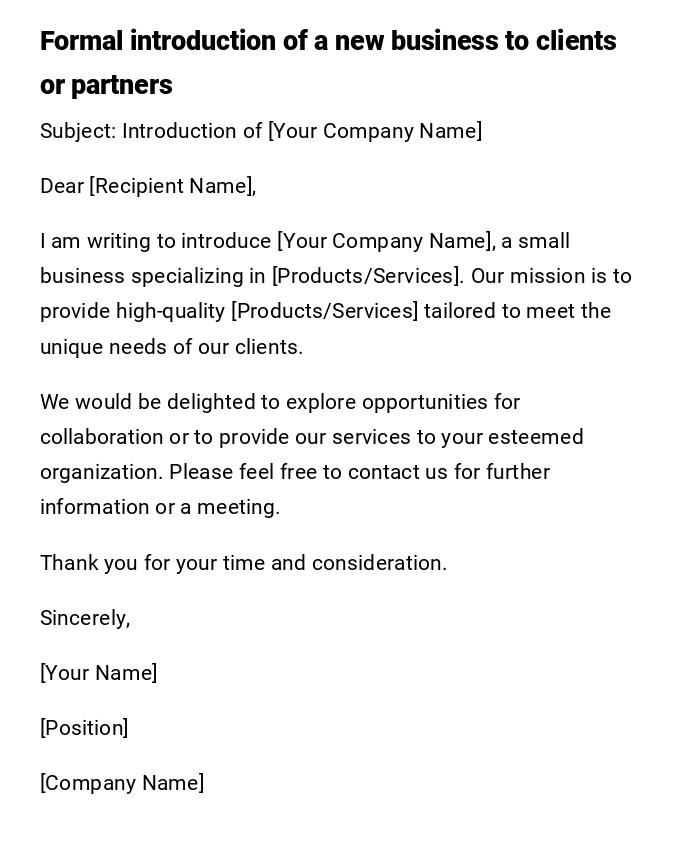
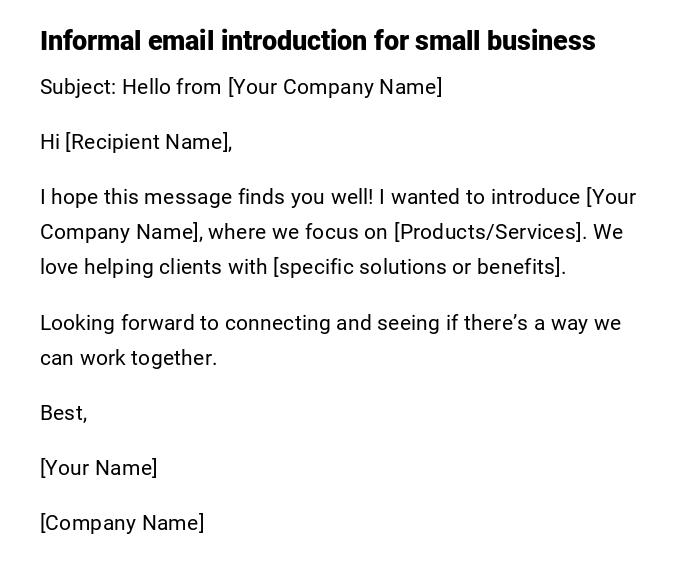
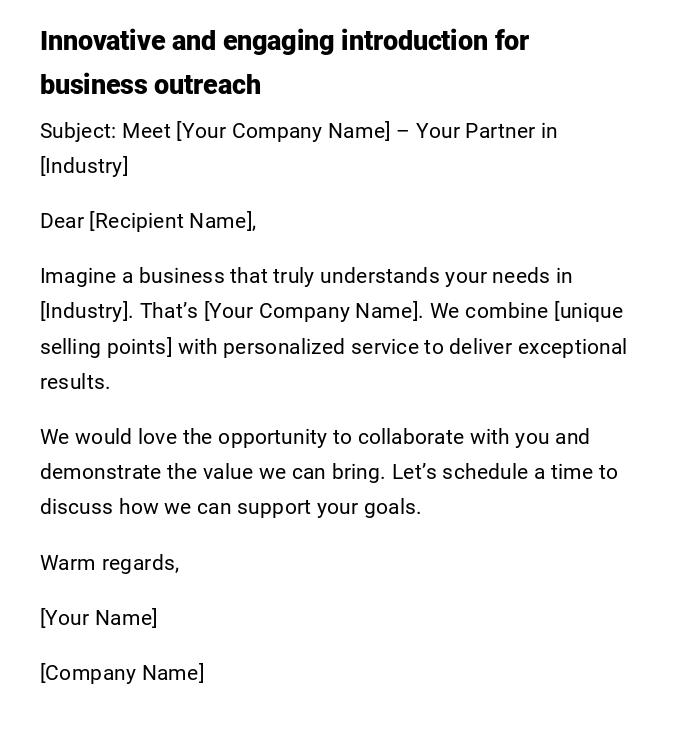
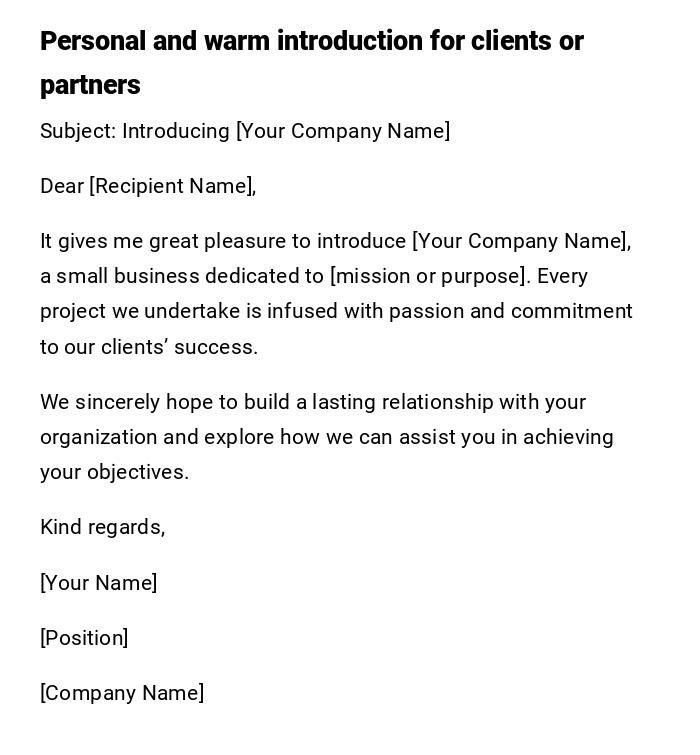
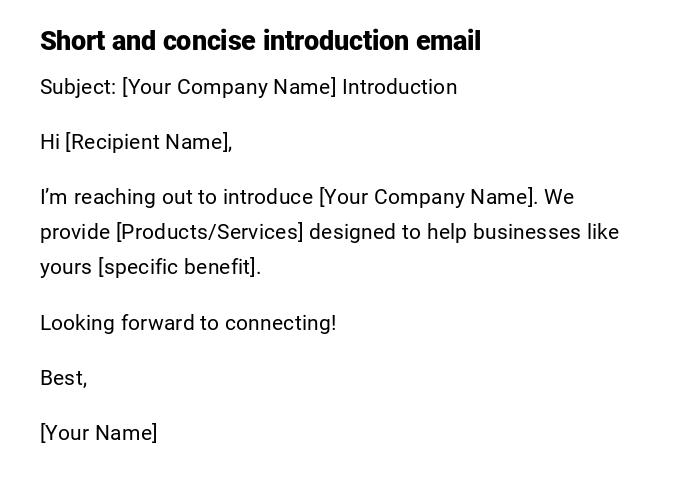
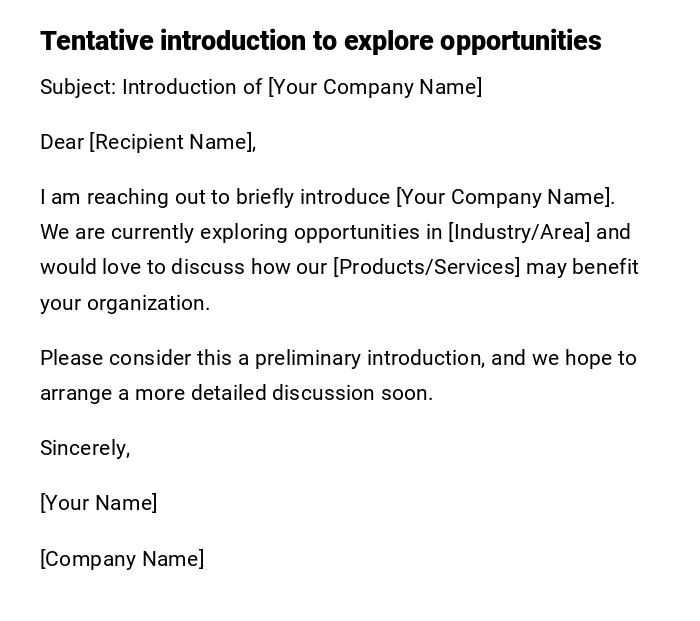

 Download Word Doc
Download Word Doc
 Download PDF
Download PDF